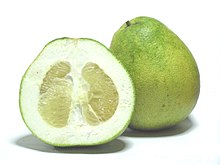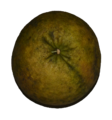Pomelo
| Pomelo | |
|---|---|

| |
| Scientific classification | |
| Kingdom: | |
| (unranked): | |
| (unranked): | |
| (unranked): | |
| Order: | |
| Family: | |
| Genus: | |
| Species: | C. maxima
|
| Binomial name | |
| Citrus maxima | |
The pomelo (Citrus maxima or Citrus grandis, alternative spellings include pummelo and pommelo, also known as shaddock[1]) is a crisp citrus fruit native to South and Southeast Asia. It is usually pale green to yellow when ripe, with sweet white (or, more rarely, pink or red) flesh and very thick albedo (rind pith). It is the largest citrus fruit, 15–25 centimetres (5.9–9.8 in) in diameter,[2] and usually weighing 1–2 kilograms (2.2–4.4 lb).
Etymology, cultivation and uses
The pomelo is native to Southeast Asia[3] and is known there under a wide variety of names. In large parts of South East Asia, it is a popular dessert, often eaten raw sprinkled with or dipped in salt mixture. It is also eaten in salads or together with yogurt, and sometimes pickled.
The pomelo tastes like a sweet, mild grapefruit (which is itself believed to be a hybrid of the pomelo and the orange[4]), though the typical pomelo is much larger in size than the grapefruit. It has very little, or none, of the common grapefruit's bitterness, but the enveloping membranous material around the segments is bitter, considered inedible, and thus usually is discarded. The peel is sometimes used to make marmalade, can be candied and sometimes dipped in chocolate or, in China, is used in stir-fry with pork.[5] Pomelos are usually grafted onto other citrus rootstocks, but can be grown from seed, provided the seeds are not allowed to dry out before planting. The seedlings take about eight years to start blooming and yielding fruit.[citation needed]
The etymology of the word "pomelo" is uncertain. It is thought to perhaps be an alteration of pampelmoes ("shaddock") or alternatively, perhaps an alteration of a compound of pome ("apple") + melon.[6]
The town of Tambun in Perak, Malaysia is particularly famous for pomelos.[citation needed] The two varieties are a sweet kind, which has white flesh, and a sour kind, which has pinkish flesh and is more likely to be used as an altar decoration than actually eaten. Pomelos are often eaten during the mid-autumn festival or mooncake festival; in Asia. They are normally eaten fresh.[citation needed]

The fruit is said to have been introduced to Japan by a Cantonese captain in the An'ei era (1772–1781).[7] The Chinese use pomelo leaves in a ritual bath, which they believe helps to cleanse a person and repel evil.[citation needed]
In rural areas in Assam, children often use pomelos as footballs.[citation needed]
In Manipur, the fruit is used as a major source of vitamin C. This fruit holds a high place in the culture and tradition of Manipur.[citation needed]
Hybrids
The tangelo is a hybrid between the pomelo and the tangerine. It has a thicker skin than a tangerine and is less sweet. The Oroblanco is a hybrid between the pomelo and the grapefruit, the grapefruit it self being a hybrid between pomelo and the sweet orange. Mandelos are another pomelo hybrid.
Gallery
-
Whole ripe pomelo from Kerala (South India)
-
South Indian pomelo cut in half
-
Pomelos
-
Pomelo after being cut
-
Sectioned pomelo
-
Flesh of a pomelo
-
Pomelo on tree
-
Ipoh pomelos on sale at Chinatown, Singapore
-
Fruit on tree; from the Philippines
-
Pomelo flower in early April
-
Yam som-o: spicy Thai pomelo salad with tamarind juice
-
Tam som-o nam pu: spicy Thai pomelo salad with crab extract
-
Fujian's Pinghe County is famous in China for its pomelos
References
- ^ "Shaddock". Britannica Online. Encyclopedia Britannica, Inc. Retrieved 13 January 2013.
- ^ Growing the granddaddy of grapefruit, SFGate.com, December 25, 2004
- ^ "Pummelo". Hort.purdue.edu. Retrieved 2012-01-07.
- ^ Grapefruit "Grapefruit". Hort.purdue.edu. Retrieved 2012-05-12.
{{cite web}}: Check|url=value (help) - ^ "Yangshuo Delicacy Pomelo Skin with Pork".
- ^ “pomelo, n.” listed in the Oxford English Dictionary [Draft revision; June 2008]
- ^ "阿久根市: 観光・特産品(ボンタン)". City.akune.kagoshima.jp. Retrieved 2012-01-07.
External links
- Pomelo Nutrition Information from USDA SR 22 database













